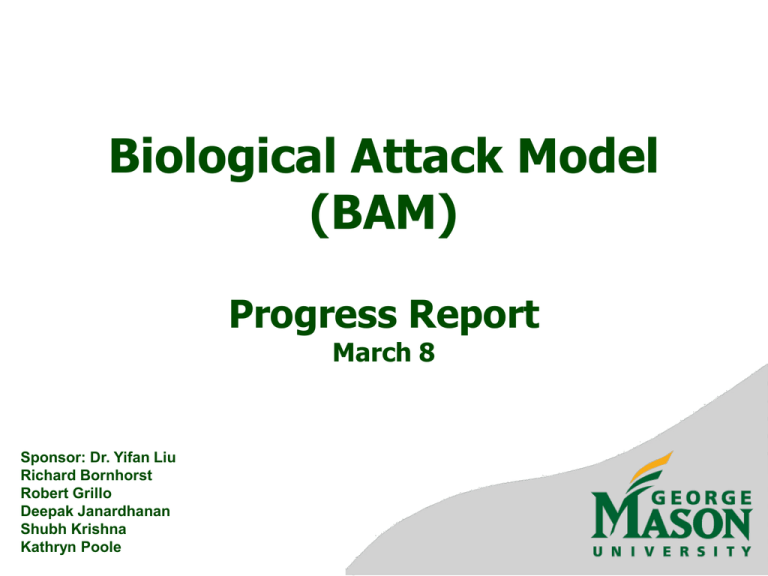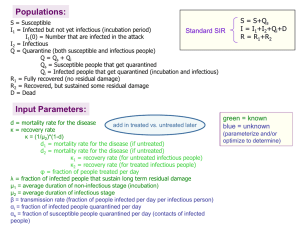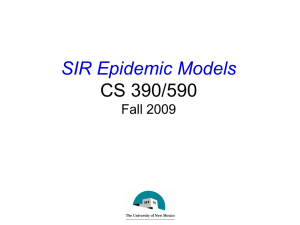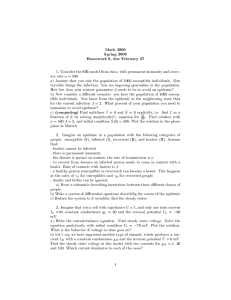Project Progress Report #1
advertisement

Biological Attack Model (BAM) Progress Report March 8 Sponsor: Dr. Yifan Liu Richard Bornhorst Robert Grillo Deepak Janardhanan Shubh Krishna Kathryn Poole Agenda • • • • • • 2 Project Plan Work Breakdown Biological Agent Parameters Assumptions Revisited Preliminary Model Overview Current Modeling Issues Project Plan Description Detailed Design and Model Development Progress Presentation Status Report # 2 Progress Discussion Testing, Evaluation, and Recommendations Formal Progress Presentation Final Report Drafting Final Report Due Presentation Preparation Final Presentation 3 WEEK 7 WEEK 8 WEEK 9 WEEK WEEK WEEK WEEK WEEK WEEK 10 11 12 13 14 15 Work Breakdown Project Task Week 7 Week 8 Units----> Project Management Configuration Mangement Group Meetings RB RG DJ 1 1 1.5 1.5 1.5 1.5 Online Discussions Status/Progress Brief Preparation Develop a disease behavioral model 0.5 0.5 3.75 Develop containment model TOTALS 5 10 10 10 10 5 10 10 10 10 12.8 19.5 15.75 19.5 19.5 12.8 21 19.5 19.5 20.5 0.5 3.75 7.5 SK KP 1.5 RB RG DJ 1 1 1.5 1.5 1.5 1.5 1.5 0.5 0.5 0.5 0.5 0.5 7.5 7.5 7.5 7.5 0.5 1 7.5 0.5 1 3.75 7.5 SK KP • 320 of 875 man-hours completed. • Ahead of schedule on modeling – End modeling phase by next brief to give an extra week to testing, evaluation, analysis, and recommendations (4 weeks) – Develop early skeleton for final report 4 Biological Agent Parameters • Smallpox (β = 3) (d = 30%) – Incubation Period: 7-17 days – Prodrome Period: 2-4 days – Symptomatic Period: 20 days • Ebola (β = 1-2) (d = 40%-90%) – Incubation Period: 2-20 days – Prodrome Period: 2-4 days – Symptomatic Period: 6-9 days • Viral Encephalitis (β = 3-4) (d = 3%-60%) – Incubation Period: 5-15 days – Prodrome Period: 2-4 days – Symptomatic Period: 7-14 days 5 Assumptions Revisited • Attack Assumptions – Single source where a certain number of people are initially exposed – Diseases will be transmitted person to person rather than airborne or food borne – Detected 24 hours after incident (may adjust for future analysis) • Population Assumptions – Constant population with no immigration/emigration, births, or deaths that aren’t related to the disease – People in the incubation stage (non-contagious) are considered susceptible in terms of quarantine and treatment since they are not yet known to be infected 6 Assumptions Revisited • Quarantine Assumptions – Various percentages of the population are quarantined to analyze effectiveness • Isolation of confirmed and suspected cases with vaccination and quarantine of contacts traced to these cases • All other quarantine is voluntary confinement – A percentage of the population cannot be quarantined • Vaccination and Treatment Assumptions – – – – – – 7 A percentage of population is already vaccinated (when applicable) Emergency response and medical staff already vaccinated (if available) Treatments are available for recovering those that receive it Vaccination and treatment have no significant side effects Those in quarantine without symptoms receive available vaccination Those showing symptoms do not receive vaccination (treatment only) Two Phases • First Phase – The spread of the pathogen before detection • Initial assumption is detection occurs after 24 hours, but this will be adjusted to analyze the importance of early detection – Only three states during this phase: Susceptible, Infected, Infectious • Second Phase – Occurs after outbreak has been identified • The status of states at end of first phase provide initial conditions for second phase • Containment strategies employed 8 Preliminary Model Diagram Track 10 different populations S+Qi1+Qi2+Qs+I1+I2+RN+RT+RD+D = N Recovered With Treatment RT Susceptible S Quarantined Infected Qi1 Infected I1 Dead D Quarantined Susceptible QS 9 Quarantined Infectious Qi2 Infectious I2 Recovered Without Treatment RN Disabled RD Preliminary Model Parameters • • • • • • • • • • 10 Transmission Rate (b) Average Incubation Length (m1) Average Infectious Length (m2) Disease Mortality Rate (d) Quarantine Rate (q) Tracing Close Contacts of Infectious (a) Number of Treated Per Day (f) Treatment Efficacy Period (b) Disability Ratio (g) Total Population (N) Preliminary Model Parameters (Excel snapshot) 11 Example Plot: 10,000 treated per day, 30% Quarantine Rate Populations 120.00% Susceptible Infected Infectious Quarantined Infected Quarantined Infectious Quarantined Susceptible Recovered by Treatment Recovered Without Treatment Disabled Dead Percentage of Population 100.00% 80.00% 60.00% 40.00% 20.00% Day Number 12 58 55 52 49 46 43 40 37 34 31 28 25 22 19 16 13 10 7 4 1 0.00% Example Plot: 10,000 treated per day, No Quarantine Populations 120.00% Susceptible Infected Infectious Quarantined Infected Quarantined Infectious Quarantined Susceptible Recovered by Treatment Recovered Without Treatment Disabled Dead Percentage of Population 100.00% 80.00% 60.00% 40.00% 20.00% Day Number 13 58 55 52 49 46 43 40 37 34 31 28 25 22 19 16 13 10 7 4 1 0.00% Example Plot: 20,000 treated per day, 30% Quarantine Rate Populations 120.00% Susceptible Infected Infectious Quarantined Infected Quarantined Infectious Quarantined Susceptible Recovered by Treatment Recovered Without Treatment Disabled Dead Percentage of Population 100.00% 80.00% 60.00% 40.00% 20.00% Day Number 14 58 55 52 49 46 43 40 37 34 31 28 25 22 19 16 13 10 7 4 1 0.00% Current Modeling Issues • Modeling a Coherent Detection Scheme • Disease incubation periods vs. appearance of symptoms • Arriving at a Balance between Number of States & Reality • Risk of Inaccuracy vs. simplification • Recovery without treatment, Side effects…. • Integrity checks to be built in • Containment as a combination of Reducing Contacts and Treatment Resource Allocation • Effective Treatment allocation issue • Availability of Emergency Responders • Effect of varying β due to Intervention efforts • Diverse Containment strategies emerging for different diseases • More data available on Smallpox than the others • Translating results into Information for a Decision Maker • Use of percentages of population vs. absolute numbers 15 Questions 16




